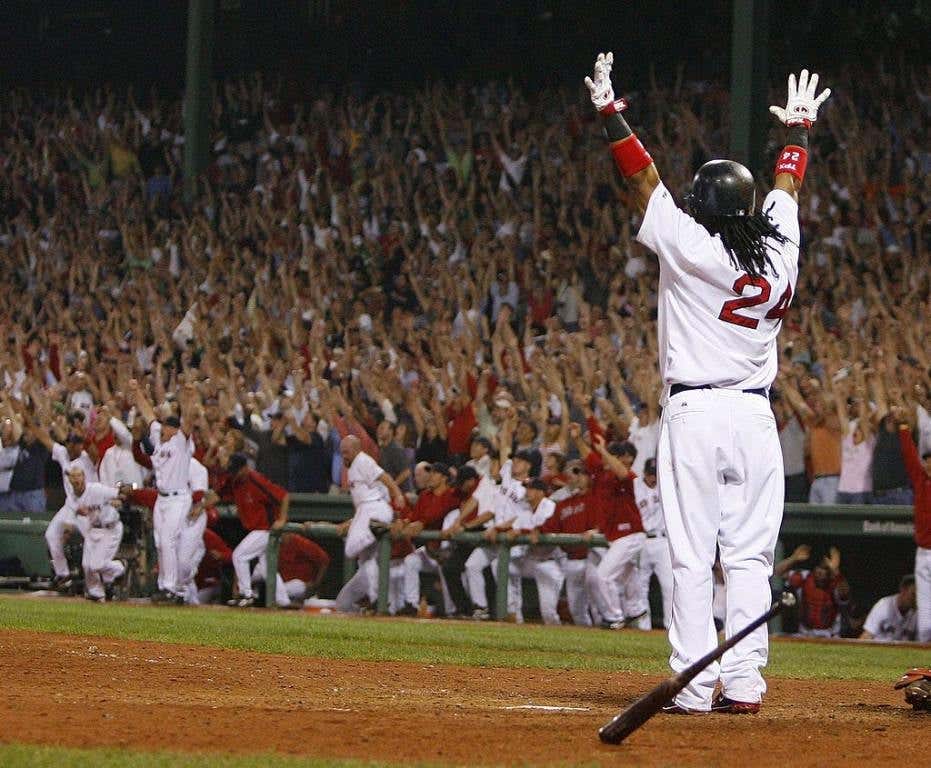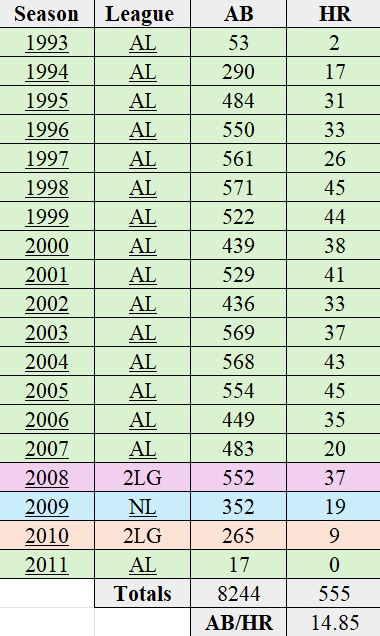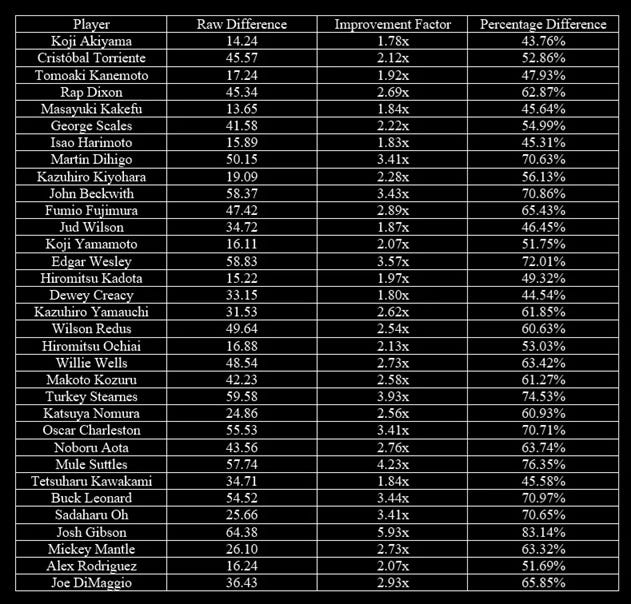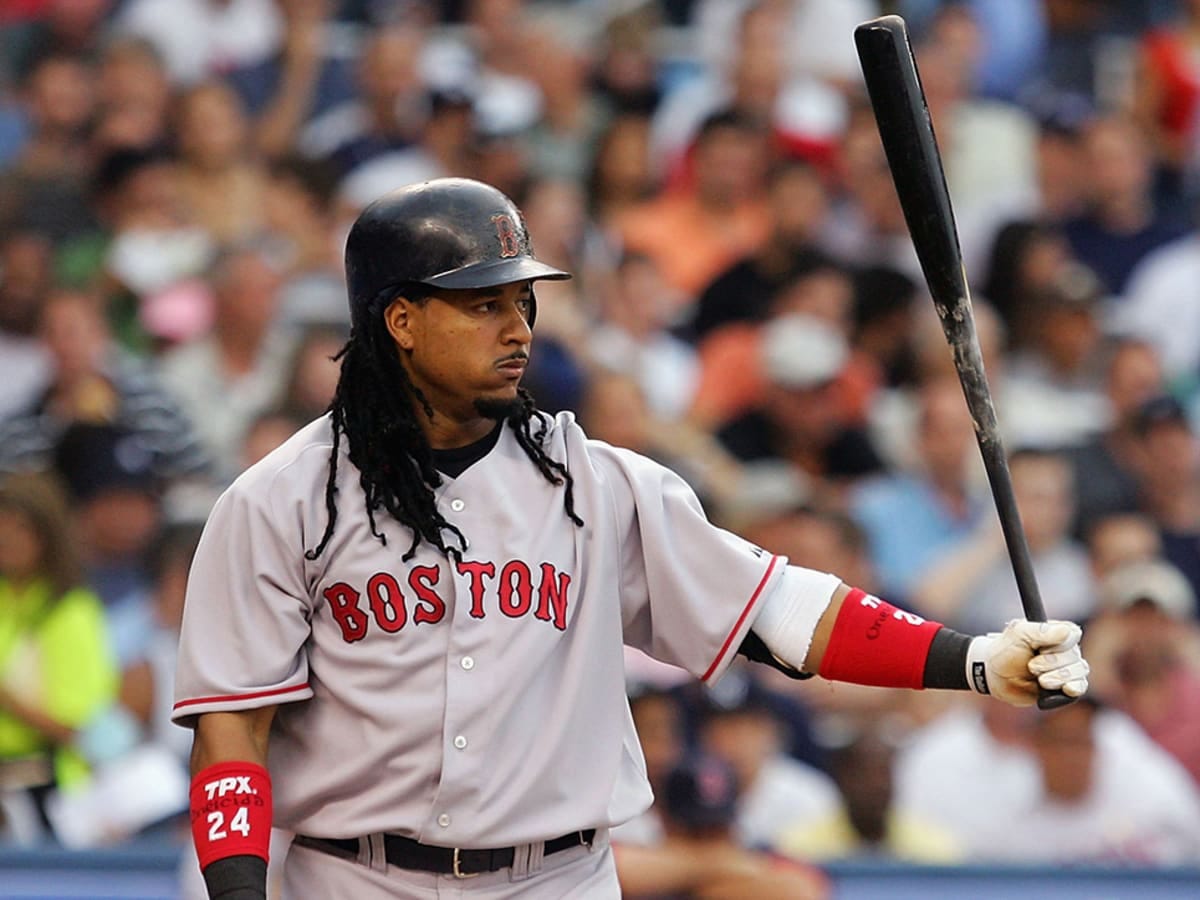This project aims to determine the greatest home run hitter of all time by comparing each slugger’s statistics to the average of their era using three formulas. The final adjusted stats will then be used to compare them head-to-head with other all-time greats.
Manny Ramirez will be the next legendary MLB slugger examined in this study. For a detailed biography of Ramirez, please click here.
Before analyzing Ramirez's career numbers, it's essential to recognize his accomplishments as a hitter. Let's examine his rankings in key hitting statistics throughout his career. Manny Ramirez appeared on the MLB leaderboards in the following categories:
1997: #9 (.328)
1999: #8 (.333)
2000: #5 (.351)
2002: #2 (.349)
2003: #8 (.325)
2008: #3 (.332)
1999: #5 (.442)
2000: #4 (.457)
2002: #3 (.450)
2003: #4 (.427)
2006: #2 (.439)
2008: #4 (.430)
1998: #8 (.599)
1999: #3 (.663)
2000: #2 (.697)
2002: #3 (.647)
2003: #10 (.587)
2004: #6 (.613)
2005: #6 (.594)
2006: #7 (.619)
2008: #2 (.601)
1999: #3 (1.105)
2000: #2 (1.154)
2002: #3 (1.097)
2003: #7 (1.014)
2004: #7 (1.009)
2005: #6 (.982)
2006: #4 (1.058)
2008: #3 (1.031)
1999: #6 (131)
2003: #8 (117)
2005: #10 (112)
1999: #8 (346)
2004: #6 (348)
2008: #4 (332)
1996: #7 (45)
2004: #10 (44)
1998: #8 (45)
1999: #7 (44)
2001: #10 (41)
2004: #5 (43)
2005: #5 (45)
2008: #4 (37)
1996: #8 (81)
1998: #7 (82)
1999: #7 (81)
2004: #3 (87)
1999: #4 (158)
2003: #7 (141)
2005: #9 (126)
2008: #2 (145)
2003: #5 (290)
2008: #4 (281)
1998: #8 (12.69)
1999: #4 (11.86)
2000: #2 (11.55)
2001: #9 (12.90)
2002: #7 (13.21)
2004: #7 (13.21)
2005: #2 (12.31)
In 1999, Ramirez achieved an extraordinary 10 top-10 rankings in MLB hitting categories. This remarkable breadth of excellence, combined with elite power, consistency, and offensive output, makes 1999 the pinnacle of his career at the plate.
His .333 batting average ranked #8 in the American League, demonstrating consistent contact in a high-offense era. His .442 on-base percentage (#5) highlighted exceptional plate discipline, while his .663 slugging percentage (#3) and 1.105 OPS (#3) placed him among the AL’s elite power hitters.
With 44 home runs (#7) and an 11.86 AB/HR (#4), Ramirez showcased fearsome power, averaging a home run every 11.86 at-bats. His 81 extra-base hits (#7) and 346 total bases (#8) further underscored his ability to drive the ball, contributing to his league-leading 158 runs created (#4), the highest offensive output in the provided data. Additionally, Ramirez scored 131 runs (#6), capitalizing on his on-base skills and Cleveland’s potent lineup.
Now that we have a clear understanding of Ramirez's accomplishments, we can proceed with the career analysis. According to Baseball Reference, Ramirez’s official statistics reveal a total of 555 home runs over 8,244 at-bats resulting in an average of at-bats per home run 14.85 (AB/HR).
Manny Ramirez exclusively played in the American League (AL) from 1993 to 2007 and again in 2011. Ramirez also competed strictly in the National League (NL) in 2009.
Ramirez played in both the AL and NL in 2008 as well as in 2010. Since the designated hitter (DH) rule applied exclusively to the AL at the time, hitters are compared within their respective leagues. To calculate the overall 2008/2010 league averages for Ramirez, we combined the league averages from both leagues.
When aggregating the statistics from each of the seasons Ramirez competed in, the league totals include 1,474,113.5 at-bats and 45,860.5 home runs, resulting in an average of 32.14 at-bats per home run (AB/HR).
With this data, we can evaluate how Ramirez’s performance compared to the average AL/NL hitter of his era.
Raw Difference: 17.29
Formula: League Average – Player Career AverageImprovement Factor: 2.16x
Formula: League Average / Player Career AveragePercentage Difference: 53.80%
Formula: (League Average – Player Career Average) / League Average × 100%
AB/HR
Ramirez hit a home run approximately once every 14.85 at-bats. A lower AB/HR indicates better home run efficiency, as it takes fewer at-bats to hit a home run. The average hitter in the leagues Ramirez played in (AL, NL, or combined for 2008/2010) required 32.14 at-bats to hit a home run, indicating that home runs were less frequent for the typical player.
Raw Difference
Ramirez needed 17.29 fewer at-bats per home run than the league average, showcasing a significant edge in power-hitting efficiency.
Improvement Factor
Ramirez was 2.16 times more efficient at hitting home runs than the average hitter. In other words, for every home run the average player hit, Ramirez hit more than two in the same number of at-bats.
Percentage Difference
Ramirez’s AB/HR was 53.80% better (lower) than the league average, reinforcing his elite status as a power hitter.
Ramirez’s 14.85 AB/HR places him among the best power hitters of his era. An improvement factor of 2.16x and a 53.80% better AB/HR than the league average highlight Ramirez’s dominance.
He wasn’t just better—he was in a different tier compared to the typical hitter. Even in an era with inflated home run numbers, Ramirez’s stats shine. The league average of 32.14 AB/HR reflects a power-heavy period, yet Ramirez’s efficiency doubled that of his peers.
In our initial case study, we analyzed the careers of prominent Japanese and Negro League sluggers, alongside MLB greats Mickey Mantle, Alex Rodriguez, and Joe DiMaggio for comparison.
Now, let's compare Ramirez’s career statistics against these baseball legends to gain a clearer perspective on how he stacks up.
Manny Ramirez’s statistics closely mirror those of Hiromitsu Ochiai (16.88/2.13x/53.03%). According to Baseball Reference, the Japanese League legend’s official statistics reveal a total of 510 home runs over 7,627 at-bats resulting in an average of 14.95 at-bats per home run (AB/HR).
Among the league leaders in home runs during the 1990s, we have analyzed the power-hitting careers of the following players:
Vladimir Guerrero (14.40/1.79x/44.23%)
Vinny Castilla (13.04/1.61x/37.95%)
Tino Martinez (12.08/1.58x/36.54%)
Shawn Green (10.13/1.47x/31.94%)
Sammy Sosa (20.59/2.42x/58.73%)
Ryne Sandberg (13.89/1.47x/31.84%)
Ron Gant (16.41/1.82x/44.95%)
Rob Deer (22.42/2.33x/57.06%)
Rafael Palmeiro (15.95/1.87x/46.43%)
Mo Vaughn (16.09/1.95x/48.82%)
Mike Piazza (17.68/2.09x/52.20%)
Mickey Tettleton (16.65/1.87x/46.47%)
Matt Williams (17.62/1.95x/48.75%)
Mark McGwire (23.70/3.23x/69.08%)
Manny Ramirez ranks 4th in improvement factor (2.16x), behind McGwire, Sosa, and Deer. He’s also 4th in percentage difference (53.80%) and 5th in raw difference (17.29), confirming his elite status among these power hitters.
Trailing only Mark McGwire (3.23x), Sammy Sosa (2.42x), and Rob Deer (2.33x), Ramirez outperformed legends like Mike Piazza (2.09x) and Rafael Palmeiro (1.87x).
In the power-heavy Steroid Era, Ramirez’s ability to hit home runs more than twice as efficiently as the average hitter cements his legacy as one of baseball’s great sluggers.
If you find this content valuable and would like to support the ongoing studies and articles, your contributions via CashApp are truly appreciated.
Your support helps fund the tools, research, and time dedicated to these projects. Every contribution, no matter the size, plays an important role in keeping this work going.
If you're unable to contribute financially, sharing this article on your social media (X, Facebook, etc.), emailing it to a friend, or texting the link to a fellow baseball fan is just as valuable.
Thank you for your support!












Before Boston, Manny was the ultimate basher. More focused. More disciplined. Imo he didn't need the HGH. He was the Cover of World Series Baseball 96' when I was a kid.